The classic thought that knitting and crocheting are reserved for the elderly is bogus. People of all ages can enjoy the benefits that come from both crafts. Several studies have been conducted over the years that support the evidence that knitting and crocheting both can positively affect the health of individuals.
I learned to crochet as a sophomore in high school and that skill carried me through some of my most stressful moments during my college days. I felt like an oddball at the time because no one understood why I crocheted before exams. After a little research, it makes so much sense now! Did you know people have actually done studies on the topic of health benefits for knitters and crocheters!?
Whether you are a seasoned knitter/crocheter or a novice, your health can be improved in many ways! And not that you need any more reasons to buy yarn, but this list of benefits that your body and mind receive from both crafts will convince you to keep that hook or pair of needles available at all times.
Let’s take a look at the list of benefits and dive into these studies!
1. Reduces Stress
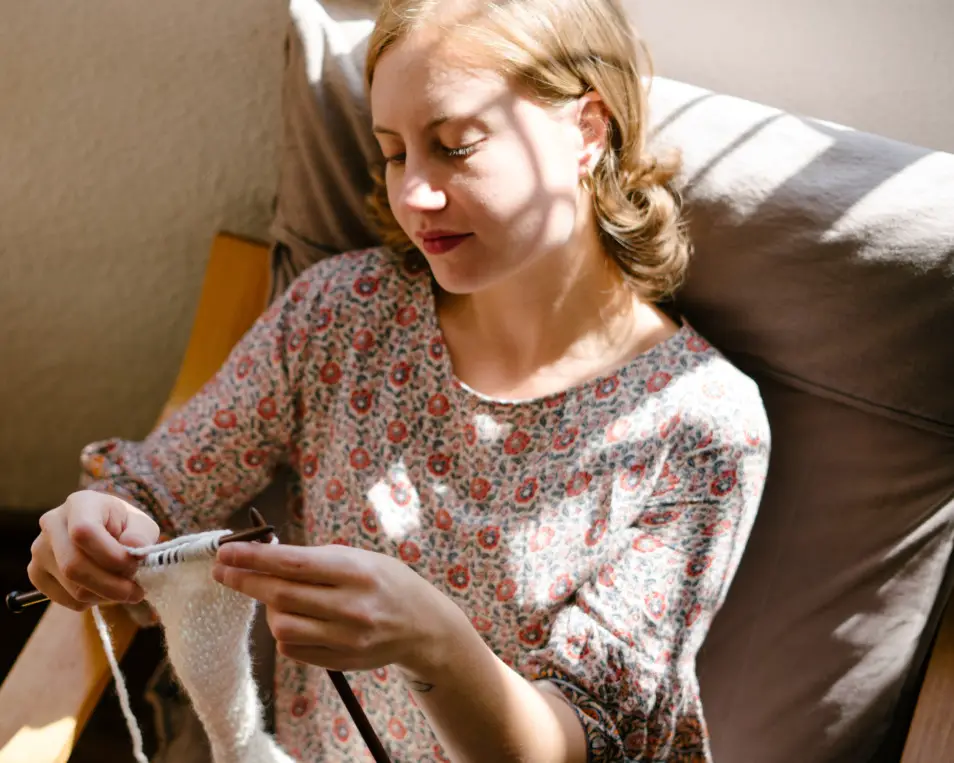
There are many claims out there that say knitting and crocheting can reduce your stress. As I already mentioned, I can attest to this personally. I used to crochet during college, especially during my first couple of years when I was taking my core math and science classes. I liked these types of classes, but that didn’t stop me from getting super stressed out around test time. So I turned to the only thing I knew would relax me, crochet.
I can distinctly remember being exceptionally nervous for my Physics I final during my second semester of college. To calm my nerves, I grabbed my project and started crocheting ferociously. I don’t remember what I was working on, but it steadied my hands and cleared my mind so I could study. I continued up until I had to leave for my final.
I wish I had come across these studies before now because my family used to tease me for crocheting while studying. Little did we know, my habit was actually of great value to me. And I am so grateful for my hobby now.
What do the Studies Say?
Stress is normal. It is your body’s natural response to change. But too much and your emotional and physical wellbeing can suffer. Which is why having a way to manage your stress is important. And according to these studies knitting and crochet can help!
“The repetitive motion of knitting induces your body’s relaxation response, lowering your heart rate, blood pressure, and muscle tension.”
Toni D. Kim
Stress reduction is among the top health benefits of knitting and crochet. According to a Craft Yarn Council survey of 3,178 knitters and crocheters, 85% of respondents reported knitting and/or crochet helped them reduce stress. If I had taken this survey, I definitely would have been part of that group!
Studies have shown that the repetitive motions of knitting (or crochet) can put you into a meditation-like state. Toni D. Kim, a licensed psychotherapist, told The Zoe Report, “The repetitive motion of knitting induces your body’s relaxation response, lowering your heart rate, blood pressure, and muscle tension.”
The term relaxation response that Ms. Kim refers to was coined by Dr. Herbert Benson, a graduate from Harvard Medical School, back in the 70’s. And it is still relevant today.
The relaxation response is the opposite to your fight-or-flight response during stressful times. The relaxation response can be induced by meditation, breathing exercises, yoga, etc. You probably don’t realize it, but by knitting you are already participating in the relaxation response.
“You are tapping into a resource which is the opposite of stress.”
Dr. Herbert Benson
To achieve the benefits of de-stressing through the relaxation response, a repetition is required. Next you push away any thoughts that come to mind and focus on the repetition. Your body will naturally relax and go into a meditative-like state.
As knitters or crocheters, our repetition is moving the needles or hook. When you get into that meditative state, Dr. Benson says, “you are tapping into a resource which is the opposite to stress.”
If you are interested in learning more about the relaxation response, please follow this link and watch the short video where Dr. Benson guides you through this stress managing technique. Or you can check out his book, The Relaxation Response.
I want to reiterate why those that knit/crochet love it. Wool and the Gang took a survey of over 4,000 knitters, an impressive amount of participants. You can find the complete survey results here. Well, 88% of respondents said they feel less stressed when they knit. The reason many of us can’t wait to get home and stitch away on a project.
2. Decreases Anxiety
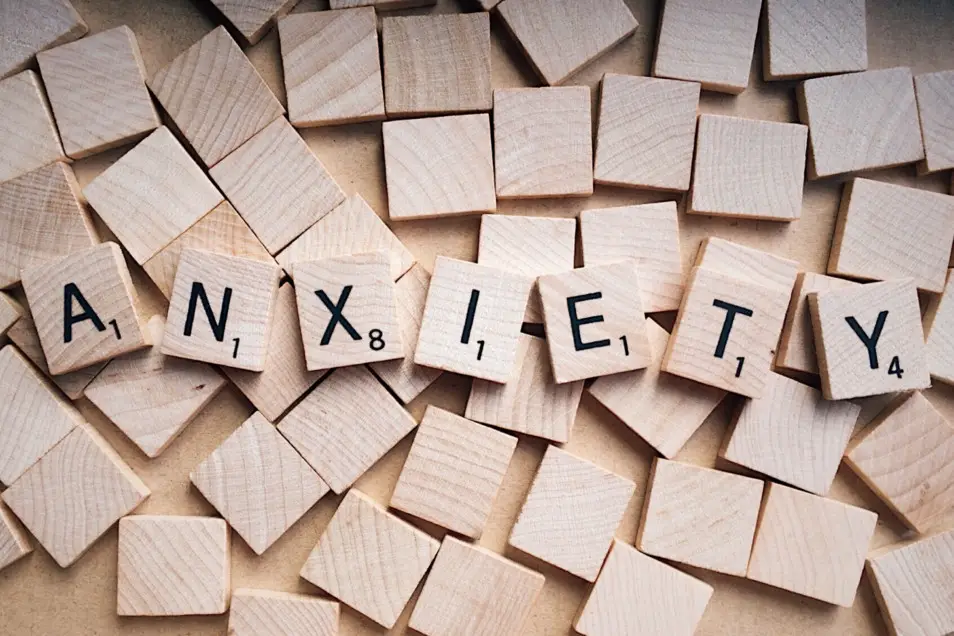
Anxiety is not a challenge I deal with personally, but I have a couple family members who deal with the ongoing battle. I have seen what a struggle anxiety can be and how it can be so crippling.
Just read this quote from a young woman, who at a young age began her challenges with anxiety after her best friend was diagnosed with stage three breast cancer at 19 years old.
“My anxiety is a high frequency vibration. I envision it as those weird ab belts from the infomercials, the ones that shake you violently until you’ve got a killer waistline. Anxiety shook me, at all hours of the day. I disappeared, physically, mentally. “
Niree Noel
It is amazing to me that you can alleviate those overwhelming feelings with such a timeless hobby as knitting. I found an article that was published on Allure that was written by Niree Noel, entitled “How Knitting Broke Me Out of an Anxiety Prison.” The quote you just read is hers and came from that article.
After watching her best friend fight for her life at such a young age, she became anxious all the time. She describes how she pulled at her eyebrows and eyelashes, lost weight, and even quit reading books. Anxiety had overcome her and she didn’t recognize herself. Not ready to give up, she turned to therapy, yoga, meditation and even tried medications. But nothing seemed to help. It was amplified when she relocated for work and she would burst into tears uncontrollably in public.
Her mom noticed and suggested she give knitting a try. So she did what all of us have done at some point: went to the craft store, picked up cheap supplies, then learned from YouTube. Slowly, she began to see a change in herself.
“When something grows in front of you, something you’ve created with your hands, you grow with it.”
Niree Noel
Knitting requires focus and perseverance from the cast-on to bind-off. Her first projects may not have been perfect, but they gave her a new determination. And slowly, she could see the person she used to be. She still knits to this day and her Instagram (@niree_knits) is full of her projects. Go check her out!
Whether you have an ongoing struggle with anxiety or know someone who does, I hope this story is an inspiration for you. And in the next section I want to cover a couple different studies that conclude the same as Niree’s story.
What do the Studies Say?
As Niree has found that knitting can help with anxiety, a Craft Yarn Council survey concludes the same. Participants of the Craft Yarn Council survey were asked whether or not they were dealing with any health challenges. Of those that answered yes, 76% reported that knitting or crocheting helped them cope. And from that group, 57% answered that one or both of these crafts helped with their anxiety.
There was also a study conducted by a group of 5 individuals from a couple different departments of psychiatry in Canada and the UK. They investigated knitting as a means to manage anxiety disorders. You can find a brief synopsis of the study, “Managing anxiety in eating disorders with knitting“, by clicking on the title.
Their subjects for the study were 38 women who were recovering from anorexia nervosa (AN). According to the researchers, recovering from AN often leaves the individual with “intrusive, anxious preoccupations with control of eating, weight and shape.” Unfortunately, this barrier can prevent progress.
During the study, each participant was given knitting lessons and free supplies. After each knitting session, they tracked their own psychological state using a questionnaire provided to them.
By the end of the study, approximately 74% of the patients stated their preoccupations with their eating disorder were cleared from their minds when knitting, in addition to less intense thoughts and fears. The same percentage also reported that knitting had a calming effect. The results of this particular study indicate knitting can benefit individuals with eating disorders by reducing their anxious preoccupations.
3. Gives Purpose

Listening to podcasts is one of my favorite pastimes when I am knitting and crocheting. One of my favorites to listen to is called “Don’t Keep Your Day Job” hosted by Cathy Heller (you need to check it out!).
The idea behind her show is that you were put in this world for a purpose and it is your duty to give that thing to the world. On the show she interviews successful people who found their passions like she did. And now she is coaching people to assist them on their journey to turning their passions into profits.
She starts every show off with the quote below, and I think it is so relevant to this section of health benefits: purpose.
“I believe that the opposite of depression is not happiness, it’s purpose.”
Cathy Heller
Knitting and crocheting both give individuals a purpose to their lives, which is so important for your body and mind. Take it from Michelle Maynard, an advocate for the health benefits knitting provides.
Michelle’s husband was diagnosed with cancer when he was still relatively young. When their world changed to the inside of a hospital, Michelle continued to knit. It was how she knew to cope with stressful situations.
During those days, there was little she could do for her husband when he was in surgery or recovering from surgery. She felt helpless for this reason. But knitting gave her a sense of accomplishment and purpose during those uncertain times. She made socks for her husband and many thank you hats, scarves and gloves. If you’d like to read more, Lion Brand has a great article written by Michelle and you can find the link here.
What do the Studies Say?
Before we get into the results of the various studies out there, I want to tell you about the founder and Executive Director of Project Knitwell, a non-profit organization that teaches knitting in hospital settings. She has a similar story to Michelle Maynard.
Carol had a daughter who required many heart surgeries as a kid. So she meant hours at the hospital with her daughter as she recovered from surgery. It was then that she took up knitting again because it gave her a distraction from the stressful situation.
Now knitting has turned into her life’s purpose. Carol started Project Knitwell in 2010. She returned to the pediatric unit where her daughter had been and began teaching mothers who had hospitalized children to knit. She can relate to those mothers and wanted to pass on the benefits of knitting to others in a similar situation.
If the testimonials are not enough, there are also surveys and studies out there that conclude the same thing. Knitting gives individuals a sense of accomplishment, which I liken to purpose. When you are fulfilling your purpose, you should feel accomplished.
In the Craft Yarn Council survey that I have mentioned before, the feeling of accomplishment is mentioned twice within the results. The first says that 44% of respondents report that a feeling of accomplishment from knitting and crocheting is one of the three most important reasons they do the craft. The second mention of the same benefit from the survey concludes that 93% of participants feel accomplished with the crafts.
It is unclear of the differentiation between the two results because the survey questions are not listed. They sound the same to me, just with different numbers. However, it is clear that a big portion of the people that answered the questions knit or crochet because they feel accomplished.
Wool and the Gang also conducted a survey of over 4,000 individuals, which can be found here, that concludes 40% of their respondents use knitting to fight their depression. And, to mention Cathy Heller’s quote again, “the opposite of depression is purpose.”
Also, according to both the Craft Yarn Council survey and Wool and the Gang survey, many crafters give their projects to charity. 60% of the Craft Yarn Council respondents said they had made projects for charity within the past year of the study. And Wool and the Gang’s survey concluded that 37% of their knitters gifted over 21 items to friends, family or charity.
Giving back to the community can give your life more purpose. It feels good to be able to give back in such a meaningful way.
4. Improves Mood
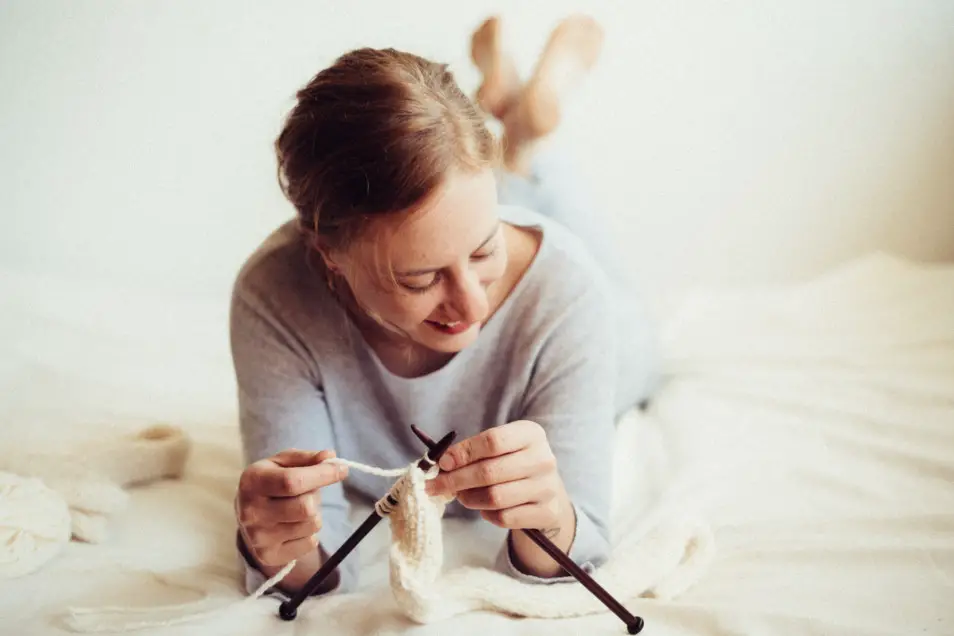
I can attest to this personally, so I hope you don’t mind me sharing a little more of my background. After I graduated university, I decided to stay in the same college town and live with my best friend for another year. I wanted time off from school to work on building this website and prepare for future travels. So, I kept my part time job working as a customer service/sales representative for a company that sold tickets to local concerts and events.
During those first weeks off from graduation though, I started panicking that I would only break even after paying bills. So I looked into other options. It was nearing time for public schools to start back from summer break and I have babysitting experience. I figured someone might be looking for a responsible person to pick up their precious child a few days a week. I wanted some extra cash, so I applied for several.
Long story short, I was promoted to a supervisor position at my sales job, given a raise, scheduled five days a week working 4 hours in the morning, and I was scheduled to pick up kids after school and stay with them until 6 pm. All within the first month of me graduating. I could not have seen that coming. I was working full-time with a part-time income! It left me tired, frustrated, and feeling that I was wasting my time.
But I have always found solace in crocheting and knitting. It calms me and I find joy in creating something with my hands. So when I walk away from a project, my mood is always 100% better. I have had some of the longest and crappiest days, but after knitting or crocheting, I feel those emotions melt away. And I am happy again.
I know I am not the only person with this sentiment because thousands of knitters and crocheters have been surveyed and numerous people relate to my claim. What about you?
What do the Studies Say?
Stitchlinks put out an online survey about the impact knitting can have on your wellbeing back in 2010. It was open for knitters worldwide and they had 3,545 participants from 39 countries. Their preliminary analysis concludes that knitting does impact mood and feelings positively. And a majority of responses said knitting made them happier. If interested, here is the link for that survey.
A survey conducted in 2014 by the Craft Yarn Council (the same one I’ve referenced many times at this point) also concludes the same. 90% of the CYC survey participants reported knitting and/or crochet improves their mood. And several mentioned their mood especially improved when knitting or crocheting in a group setting.
And if you don’t believe these findings, just ask any seasoned knitter or crocheter. I guarantee you they will tell you their mood is boosted when working on a project!
5. Fights Addiction
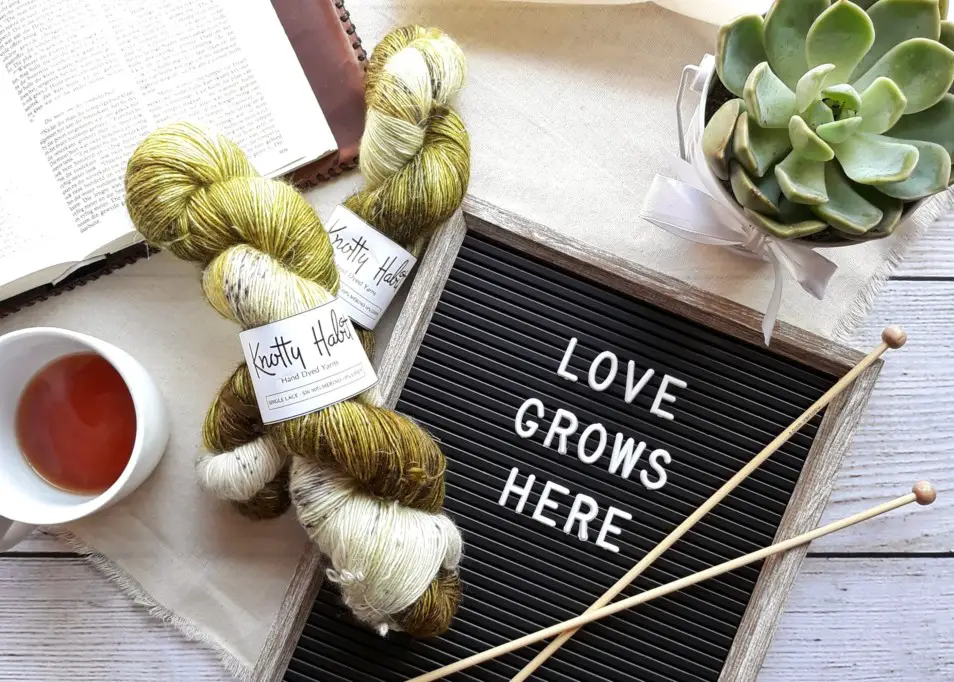
As I have mentioned several times through this post, knitting is a form of meditation. It brings you into this zen-like state. And it’s magical! But did you know that knitting can be a healthier replacement for habits such as smoking, drinking and drugs?
There is a lady named Stephanie who recovered from alcoholism through knitting. After a knitting lesson by a former alcoholic, she found a parallel between knitting and her life. It’s a profound realization and I’ll do my best to paraphrase what she told her instructor. If you want to read the full quote, I have it linked here.
Unraveling projects again and again because the stitches looked wrong or the pattern was incorrect reminded her of how she approached life. She strived for perfection, but if she got it wrong, she would relapse then go back to rehab to start over. When she began knitting, she made an agreement with herself that she would finish the project no matter what and appreciate it, mistakes and all. Realizing that mistakes can be beautiful and accepting them, she was able to move forward with her life and recovery.
Knitting and crochet are powerful tools, but I never grasped that until I read that woman’s story.
What do the Studies Say?
I know there are studies out there, or at least living examples, where knitting helped individuals fight addiction. However, upon my research, all I could find that seemed to be an “actual” study, I had to pay for the article and it didn’t disclose much.
But there are organizations out there that help individuals recover from substance abuse or smoking throught knitting. There is one called Knit to Quit, which is dedicated to helping smokers quit their habits through knitting. Their website (found here) gives three reasons for how knitting is effective at breaking the habit of smoking:
- Knitting requires use of both hemispheres of the brain at the same time. Your body relaxes while you still maintain concentration, which according to them, gives the same effect as nicotine.
- Knitting triggers the release of endorphins, and so does smoking.
- Addictive habits need to be replaced rather than abandoned. Knitting is a good replacement because it relaxes the body and has other similar effects to smoking.
Stitchlinks has a great list of reasons how knitting can help with addiction. There are 25 reasons mentioned in the document, which you can access here. But I’ve provided a short summary:
- Knitting occupies your hands and mind.
- When your hands are occupied, your previous habit is no longer needed to fill the time.
- The portability of knittng is perfect for when cravings happen.
- Creating items with your hands can instill more confidence, self-esteem and add more purpose to your day.
6. Has Therapeutic Effects
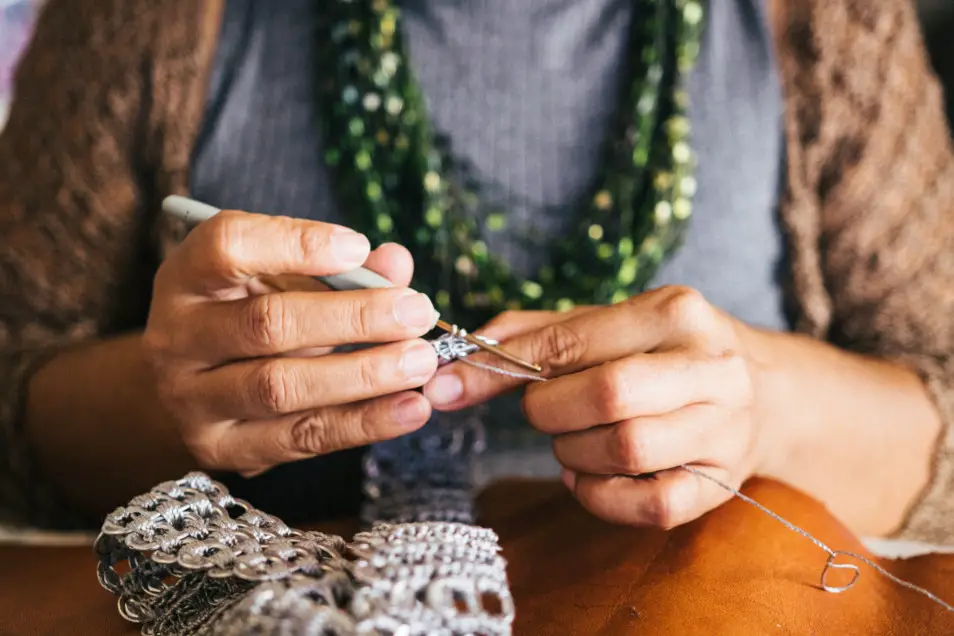
Knitting and crochet are accessible and inexpensive hobbies that can be used for self-care routines because of their therapeutic effects. In fact, their is a nonprofit organization called Project Knitwell that dedicates resources to teaching individuals in hospital or community settings how to knit as a way to cope with their stressful situations.
Carol Caparosa, whom I mentioned previously, is the founder of Project Knitwell. And the non-profit did a study with oncology nurses that investigated how knitting could impact their compassion fatigue. The results are positive and illustrate the therapeutic effects of knitting.
Betsan Corkhill, founder of Stitchlinks, is a physiotherapist and lifestyle health coach. She also is a firm believer in the therapeutic benefits that come from knitting. She has written much literature and contributed greatly to this topic.
What do the Studies Say?
The study done by Project Knitwell had 39 nurses participate from MedStar Georgetown University Hospital in Washington DC. Each nurse had at least one year experience and worked either part-time or full-time in one of two units: inpatient hematology or oncology units.
For these nurses compassion fatigue is a big issue. It can lead to high turnover rates, poor job satisfaction and inadequate care. “Compassion fatigue is emotional exhaustion and stress that nurses can feel when caring for terminally ill patients (The Impact of Knitting Intervention).
Project Knitwell came into the hospital for 6 weeks and taught knitting lessons to the nurses. All the materials were provided and placed in baskets for each nurse to receive. When the nurses were on break, on lunch or after a stressful situation, they could attend the lessons. The response was positive.
In order for Project Knitwell to quantitatively measure the results, they provided a survey for the nurses to fill out before and after the knitting intervention. Compassion fatigue and burnout scores improved, especially for the nurses who had low initial scores. One nurse commented, “I really enjoyed the soothing rhythm of knitting and creating something useful.”
Oncology nursing is very demanding and the staff members definitely need ways to de-stress, enjoy life, etc. So learning a new creative skill is a good way to help accomplish this.
Oncology Nurse From Project Knitwell’s Study
One can conclude from the results of this study that knitting can help oncology nurses de-stress and help with compassion fatigue. Another nurse completed her survey with this statement: “Oncology nursing is very demanding and the staff members definitely need ways to de-stress, enjoy life, etc. So learning a new creative skill is a good way to help accomplish this.”
7. Helps with Loneliness

Feelings of loneliness or isolation can lead to depression. And I don’t have to tell you that depression is not healthy, mentally or physically. But, sticking with the theme of this article, knitting and crocheting can help!
Many local yarn stores or people in the community hold knit nights once a week. A group will either gather at a yarn shop, coffee shop, or even home, to knit together and chat the night away. It’s a fun way to work on your project of choice and catch up with old friends or meet new ones.
Knit nights once a week with the gals can mitigate those feelings of loneliness or isolation.
What do the Studies Say?
Stitchlinks did some research on knitting and its impact on chronic pain, and it took a look at the role of knitting groups. Find the study here. The results were interesting to me. A lot of participants mentioned that knitting in groups really helped them. It makes sense. Many people who suffer from chronic pain can start feeling isolated and helpless.
Take a look at the summary of the study results below:
- 3 themes were established: esteem, rhythmic movement and stimulation.
- Knitting gives individuals a sense of belonging and an identity within a group setting.
- Bonds were formed between knitters who met in groups. Many extended outside the knit meetings.
- Knit groups offer individuals an opportunity to have effective social support.
- Knitting for others gives a new purpose and feelings of loneliness can melt away.
8. Reduces Risk of Memory Loss

Did you know that making sweaters and hats and baby blankets can actually reduce your risk of memory loss? It’s amazing!
While it is not proven that knitting or crochet alone can halt memory loss, there is no doubt your brain is positively impacted. Knitting uses all parts of your brain. So does crochet, just insert hook anywhere a needle is referenced. Think about it:
- Your frontal lobe is engaged when you are thinking about the pattern and planning your stitches.
- The temporal lobe is engaged in storing memories about the project.
- The cerebellum coordinates movement of the needles and the timing of stitches.
- The occipital lobe is how you are seeing what you are knitting.
- And finally, the parietal lobe is processing the feel of the yarn and the needles.
What do the Studies Say?
Knitting and crocheting stimulate brain cells and help keep them quick and efficient. But don’t take my word for it. Let’s look at the studies that point to the conclusion that cognitive impairment could in fact be prevented by activities such as knitting or crocheting.
The Mayo Clinic Study of Aging, found here, in Olmsted County, Minnesota studied a group of 1,321 individuals who were between the ages of 70 – 89. They were looking at the association of cognitive activities with mild cognitive impairment (MCI).
Each participant was interviewed by a research nurse or psychometrist. They were asked about how often they engaged in cognitive activities within the year leading up to the study. Cognitive activities were defined as reading books or newspapers, craft activities (like knitting or quilting), playing games, computer activities, social activities, and watching tv.
In their findings, individuals who used the computer, played games, knitted or quilted, read books or watched minimal tv had a reduced risk of having MCI by 30% – 50%.
There are some limitations to this study, such as the recall bias or the person that happened to do a certain activity lived an overall healthier life. But, there is more evidence now thanks to the study that shows mental activities, such as knitting, can decrease the odds of MCI.
Resources
The Craft Yarn Council website has a great collection of studies regarding knitting and crocheting that have been conducted over the years. If you click the link, navigate to the wellness section and view them for yourself!
I mentioned several of the studies on the CYC site, but I also did some research of my own. I delved into each topic further and found even more studies. However, I was not able to mention all of the studies, nor did I have enough room on the page to list them.
So I created a separate page dedicated to resources on wellness and yarn crafts. And as new studies come out, I will update the page. You can find it here by clicking on the link. Hope this is enlightening!
I also feel I should mention that many of the studies were solely related to knitting. However, I think you achieve the same benefits by crocheting. So if you only see knitting, know that crochet applies as well.
